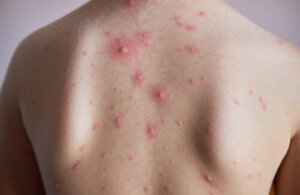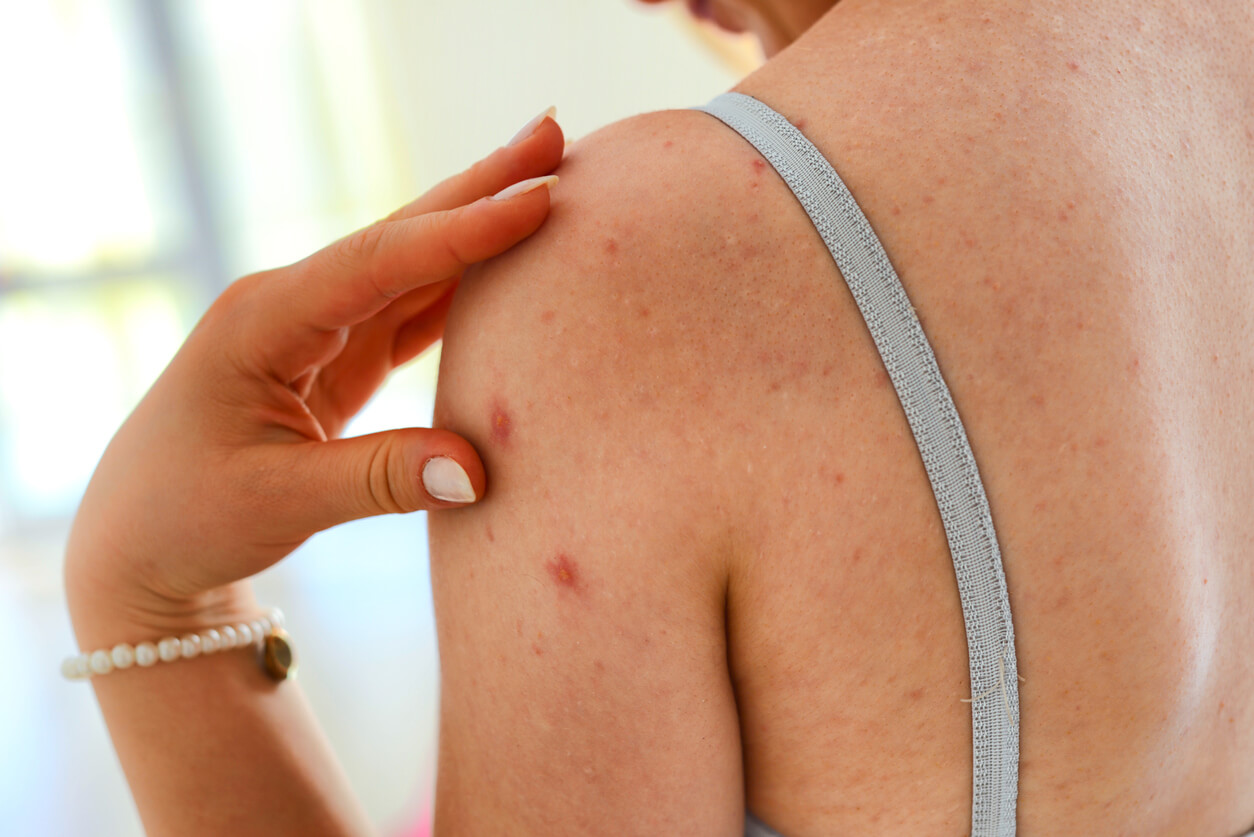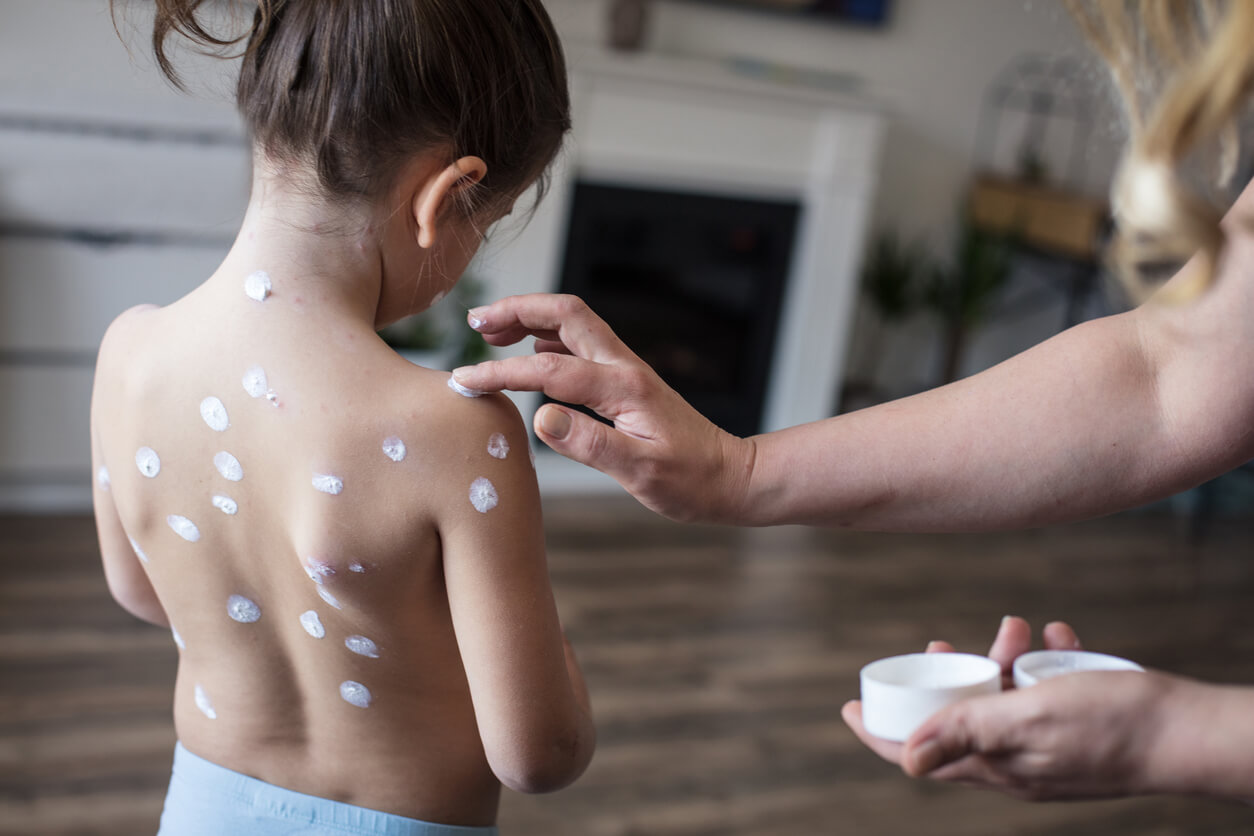How to Prevent and Treat Chickenpox Scars


Written and verified by the dermatologist Maria del Carmen Hernandez
Chickenpox scars are lesions that are rarely evident at the doctor’s office. This is due to the measures and care taken during the disease to avoid their evolution. It’s a very contagious disease that involves intense itching and subsequent scratching, with the consequent generation of scarring lesions. In the following article, we’ll tell you what you can do to prevent and treat chickenpox scars.
What is chickenpox?
Chickenpox is an infectious disease of viral origin, is highly contagious, and affects children preferentially. In fact, more than 90% of unvaccinated people become infected. Moreover, it occurs at different ages and in different parts of the world.
Typical symptoms include an intensely itchy rash with red blisters, accompanied by a mild fever. In addition, the rash first develops on the face and torso. It then spreads to the scalp, arms, and legs. Intense itching is the biggest problem of the disease because it often makes it difficult to sleep.
Read also: What Are Those Little Red Spots on My Baby’s Skin?
How to prevent chickenpox scars?
Chickenpox disease is characterized by the presence of different types of lesions on the skin simultaneously. That is, blisters, scabs, or residual lesions can be observed at the same time. Here’s how to prevent the marks caused by this condition.

Avoid scratching
The symptom that predominates over all others is extreme itching, which produces an imperious need to scratch. Residual marks tend to occur when the chickenpox lesions are rubbed and scratched. Avoiding this is one of the premises that’s important to respect because it prevents over-infection of the skin surface and scarring in the future. Also, trimming the nails and grooming them helps to avoid rubbing and infecting the lesions.
Use appropriate clothing
Itching can be accentuated by the use of certain garments. Therefore, it’s best to wear those that are looser and made of natural fibers, such as cotton. Synthetic and tightly woven fabrics don’t soothe the itching sensation and may cause irritation to sensitive skin or lesions developed by chickenpox. Even wearing too many clothes at the same time stimulates perspiration and consequent itching.
Use sun protection
Like all recent scars, residual chickenpox scars shouldn’t be exposed to ultraviolet rays. To protect them, they should be covered with clothing and sunscreen should always be used. Sunscreen should have SPF 50 or higher and its application should be renewed every two hours. Sun exposure causes stimulation of melanogenesis and hyperpigmentation of lesions. For its part, the American Academy of Dermatology Association strongly recommends the use of sunscreen on scars to prevent the development of skin cancer.
Resorting to antipruritic medication
When itching’s very intense, scratching the lesions and even injuring them can be inevitable. Therefore, it’s a good idea to go to a specialist doctor to prescribe an antihistamine drug to soothe the itching and not produce subsequent marks. The medication to alleviate the symptoms can be taken orally, through tablets or capsules, or by means of topical agents. Calamine lotions and cetirizine tablets are known examples.
You may be interested in: Types of dermatitis in children

Take hygienic measures in the bathroom
When bathing and showering, it’s best to use warm water and for the duration of the showers to be short. This helps to keep the protective lipid mantle of the skin intact to avoid subsequent irritations. In addition, the use of neutral or syndet soaps keeps the skin moisturized and reduces the chances of itching due to skin dryness.
Use rosehip oil
Nowadays, there are multiple oils with medicinal functions. One of them is rosehip oil, which is very useful for the care of the skin’s surface. It offers important beneficial characteristics in the treatment of stretch marks, scars, and skin flaccidity. This is thanks to its high content of polyunsaturated fatty acids, linoleic acid, linolenic acid, and vitamins A, E, and C (associated with collagen synthesis).
According to studies in the Journal of Cosmetics, Dermatological Sciences and Applications, the use of rosehip oil twice a day for 3 months can help to reduce the appearance of a scar.
Prevention is better than treatment when it comes to chickenpox scars
Although the scars that develop from chickenpox are treatable, it’s best to prevent them at the time of illness. The most important care measures to avoid remaining with these marks are the use of sunscreen on a daily and constant basis and avoiding scratching the lesions. In other words, the scabs should be left to fall off by themselves.
All cited sources were thoroughly reviewed by our team to ensure their quality, reliability, currency, and validity. The bibliography of this article was considered reliable and of academic or scientific accuracy.
- Mármol I, Sánchez-de-Diego C, Jiménez-Moreno N, Ancín-Azpilicueta C, Rodríguez-Yoldi MJ. Therapeutic Applications of Rose Hips from Different Rosa Species. Int J Mol Sci. 2017 May 25;18(6):1137. doi: 10.3390/ijms18061137. PMID: 28587101; PMCID: PMC5485961.
- Facts about chickenpox. Paediatr Child Health. 2005 Sep;10(7):413-4. doi: 10.1093/pch/10.7.413. PMID: 19668650; PMCID: PMC2722564.
- Tebruegge M, Kuruvilla M, Margarson I. ¿El uso de calamina o antihistamínico proporciona alivio sintomático del prurito en niños con infección por varicela zóster? Arch Dis Child. Diciembre de 2006; 91 (12): 1035-6. doi: 10.1136 / adc.2006.105114. PMID: 17119083; PMCID: PMC2082986.
- Johnson AW. Soap opera and winter itch: synthetic detergent bars (syndets) provide superior mildness compared with soaps. Skinmed. 2004 Sep-Oct;3(5):251; author reply 251-3. doi: 10.1111/j.1540-9740.2004.03685.x. PMID: 15459993.
This text is provided for informational purposes only and does not replace consultation with a professional. If in doubt, consult your specialist.








